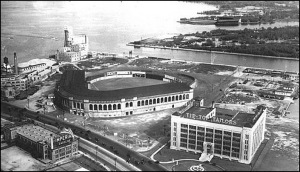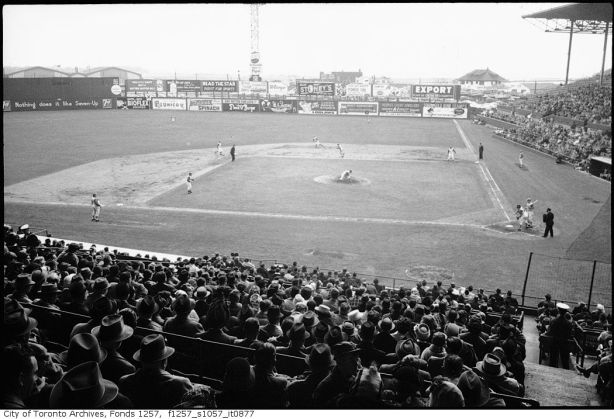Early Days
In 1895, the Toronto Base Ball Club became a charter member of the old Eastern League. For the first five years, they used the nickname “Canucks“. In 1899, they decided to try the name “Maple Leafs” on for size. In 1902, that became the team’s official nickname. “Like the hockey team!” I hear you exclaim. Actually, early in the 20th century, the professional hockey team in Toronto played under various handles (Blueshirts, Arenas, St. Patricks). They didn’t start using the moniker “Leafs” until Conn Smythe bought the team in 1927. By that time, the baseball club had used that name for a quarter-century.
Though the official Minor League level designations that we’re used to nowadays didn’t exist then, the Eastern League was regarded as Class “A” ball; at the time, one level below the majors. When it was decided to have a level above that (“AA”) in 1912 , the Eastern League (and the Leafs) moved up. Now renamed the “International League“, they would stay there until the end of World War II.
Starting in 1897, the team played their home games at Hanlan’s Point Stadium on the Toronto Islands. The stadium there burned down in 1909, and was replaced by a larger concrete structure the following year. It was in this ballpark that a visiting player, a 19-year-old lad named George Herman “Babe” Ruth, both pitched a shutout and hit a home run into Toronto Harbour on September 5, 1914.
The New Jewel of a Ballpark
Long dingers weren’t the only thing that Hanlan’s Point couldn’t contain; by the early 20’s, baseball’s increasing popularity meant that the Leafs needed a new home. In 1926, they got one; Maple Leaf Stadium, a brand new 23,000-seat facility at the foot of Bathurst Street on the south side of Fleet Street (now Lake Shore Boulevard).

Aerial view of Maple Leaf Stadium, clearly showing its location between the (now) Omni TV building, and the Tip Top Tailors building.
Designed by Chapman, Oxley and Bishop (the same architects that crafted such Toronto landmarks as the Sunnyside Bathing Pavilion, the Palais Royale and the Prince’s Gate at the Canadian National Exhibition), it was a fine example of a single-tier “jewel box”-style stadium, as the ornate concrete stadia of the early 20th century are sometimes called.
The team, and its ballpark, suffered the ups and downs of the next twenty years; the Great Depression, which severely affected attendance, and the Second World War, which sent both fans and players overseas on active duty. These upheavals almost caused several Major League teams to go under, and the trickle-down effect in the minor leagues was more severe. The dire economic situation did, however, spawn one innovation; direct affiliations between Major League and Minor League teams. In St. Louis, General Manager Branch Rickey astutely realized that rather than buy the best players from minor league clubs for top dollar, it actually made economic sense to control several minor league teams and develop talent yourself. You can then promote the good players, and release the rest. Rickey’s “Gas House Gang” Cardinals of the 1930’s pointed the way; the other Major League teams could not help but follow.
In 1946, minor-league levels were adjusted again. The new top tier was “AAA”, and three existing leagues were given that designation; The Pacific Coast League (on the West Coast), The American Association (the Midwest) and, of course, the Leafs’ home, The International League (the Great Lakes and Eastern Seaboard). By this time, more & more Major League teams had embraced Rickey’s idea of a “farm system” but, rather than buy an interest in a minor-league team, signed their affiliates to a new kind of agreement called a “Player Development Contract“, giving them exclusive control over a minor league team’s roster for a defined period. Teams that embraced this system (especially the Cardinals, Yankees and Dodgers) thrived in the post-war period.
1946 was a landmark year in another sense; it was the first year of integration in the IL, as Jackie Robinson joined the Leafs’ Canadian IL rivals, the Montreal Royals.
New Ownership, New Success
In 1951, media mogul Jack Kent Cooke purchased the team. Cooke had made his fortune

Cooke, right, switches hats with team manager Joe Becker
buying & selling radio stations and newspapers throughout eastern Canada. Like Bill Veeck, he understood the value of appealing to the casual fan; he began staging almost as long a list of promotions and celebrity appearances as Veeck was in St. Louis. Cooke was quick to share his strategies with the rest of the IL, realizing that a strong league meant greater stability for all. His efforts earned him a “Minor League Executive of the Year” award from The Sporting News.
Though he did have a player development contract with Veeck’s Browns in the early ’50’s, Cooke soon returned to the old ways; developing young players, picking up other teams’ reclamation projects, and selling the result on to the highest bidder. For a time, it gave them a real edge in the IL; Toronto finished either first or second in the league every year from 1954-58.

The final days of the glory years: May 1961.
Alas, Cooke’s other interests began to interfere with the ballclub. in 1960, he was denied a license to operate the first privately-owned TV station in Toronto (the license ultimately went to Cooke’s rival, Ted Rogers, who launched CFTO-TV).
Within weeks, Cooke had applied for US citizenship. He moved to Washington, DC and started to sell off his Canadian assets. Relocation only seemed to whet his appetite for sports ownership; in 1961, he bought a 25% stake in the Washington Redskins. In 1965, he bought the Los Angeles Lakers outright and then, in 1966, after being awarded the NHL‘s expansion franchise for LA, built the Los Angeles Forum in the suburb of Inglewood to house both the Kings and the Lakers.
Decline and Fall
Though Cooke retained an interest in the Leafs until 1964, the writing was on the wall. The old stadium was beginning to show its age, and no-one wanted to pony up for the necessary repairs. There was a drive for public ownership but, with Toronto now seeing itself as a “Major League” city (and with Major League Baseball now regularly available on network TV), minor league ball seemed a quaint anachronism.
After the 1967 season, the team was purchased by real estate developer Walter Dilbeck, who moved the operation to Louisville, Kentucky and renamed them the Colonels. The club moved again in 1973, this time, to Pawtucket, Rhode Island. Renamed the Pawtucket Red Sox, they continue to operate there to this day.
The Jewel of a ballpark, neglected since the mid-fifties, never saw another ballgame. In 1968, Maple Leaf Stadium fell to the wrecker’s ball.